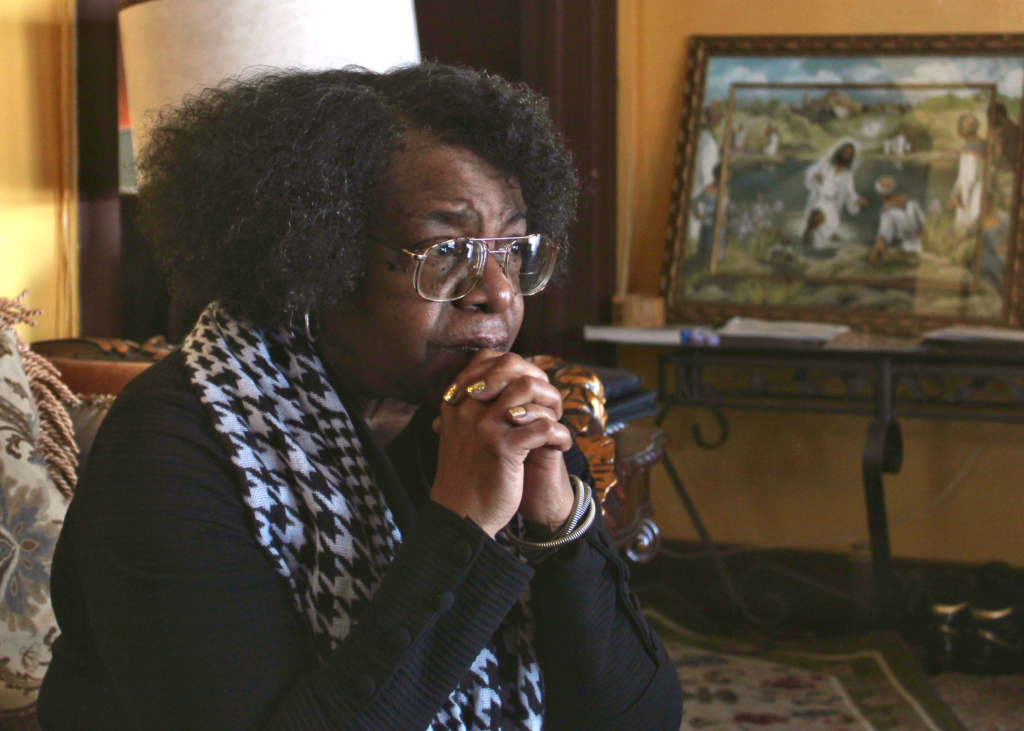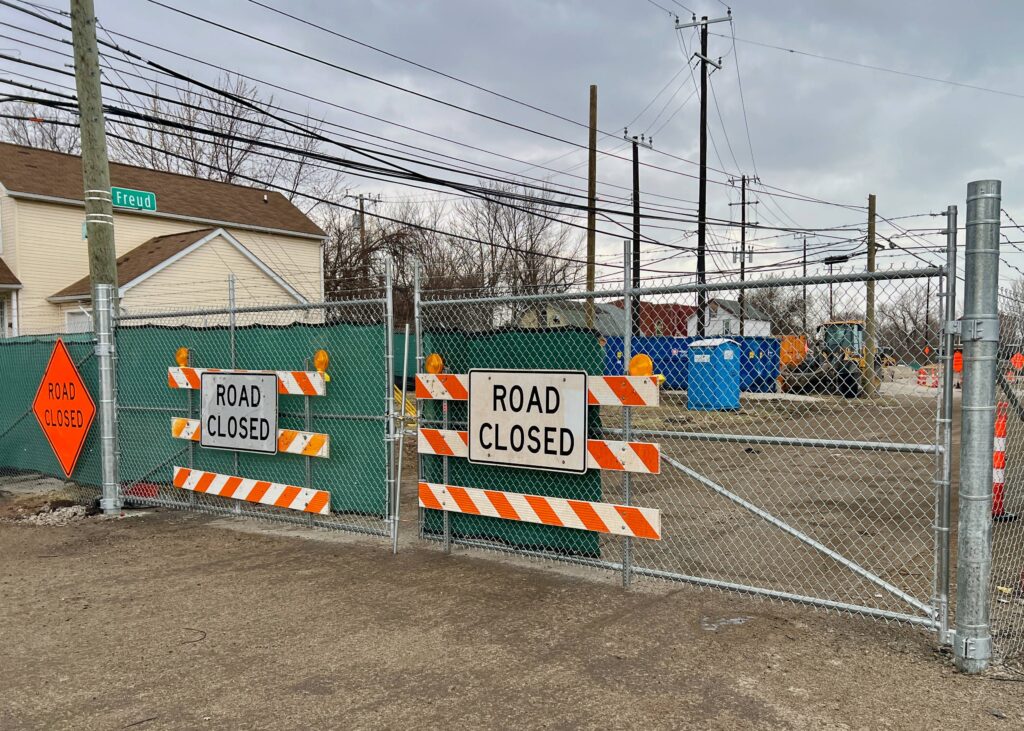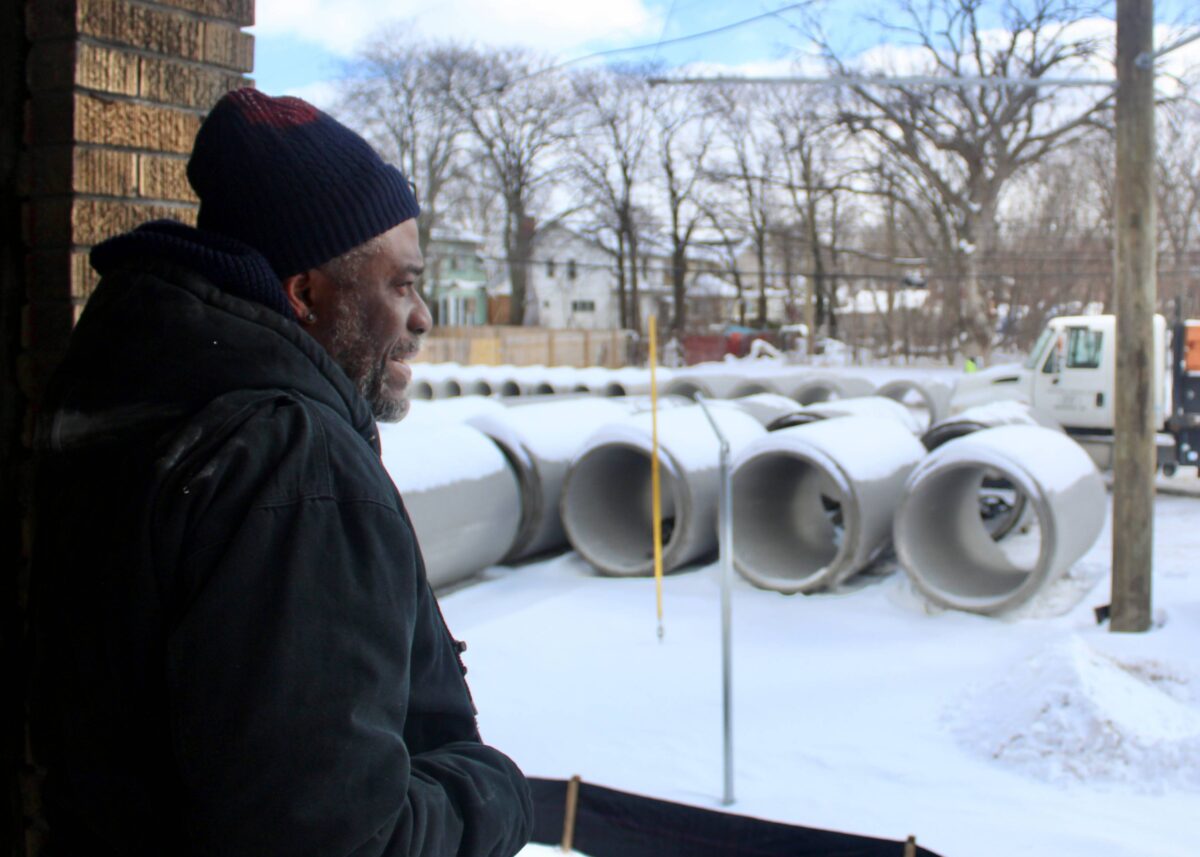Overview:
-Detroit's Jefferson Chalmers residents are grappling with a $138 million Great Lakes Water Authority pump station project.
-Construction has already altered the neighborhood, with heavy machinery paving the way for a new five-story facility.
-"I don't know why they would put an [industrial] building in the middle of a residential neighborhood," resident Vanessa Cartwright tells Planet Detroit.
On a frigid Monday morning in February, the only thing distracting Jefferson Chalmers residents from the freezing temperatures was the dull drill of heavy machinery echoing through their neighborhood.
The noise came from a construction crew clearing the way for a five-story Great Lakes Water Authority pump station in the heart of this predominantly residential area on Detroit’s east side.
The $138 million Freud Pump Station Improvement Project is expected to take four years to complete. GLWA says it will improve the maintenance and reliability of the east side’s two major pump stations, which are critical for handling wastewater and stormwater during heavy rain events. But many residents say they weren’t given a real chance to weigh in on the project before it began — and now they’re left to deal with the consequences.
“It took me a minute to realize this is actually happening,” Vanessa Cartwright, a longtime Jefferson Chalmers resident, told Planet Detroit. “I’m not a crybaby, but I’ve cried a couple of times. This is really serious, and I don’t know why they would put an [industrial] building in the middle of a residential neighborhood.”

Jefferson Chalmers resident Vanessa Cartwright inside her home. Her Algonquin Street house, where she’s lived since 1996, is adjacent to the construction of GLWA’s $138 million pump station project. Photo by Ethan Bakuli.
GLWA says the project is necessary to prevent infrastructure failures like the catastrophic flooding of June 2021, when pump station malfunctions contributed to widespread basement backups and street flooding across Detroit’s east side.
The new facility will allow for the isolation of sanitary flow, making maintenance on the existing Freud Storm Pump Station safer and more efficient. “This is about ensuring long-term reliability and resilience for the entire region,” said Navid Mehram, GLWA’s chief operating officer for Wastewater Operating Services.
Residents like Jay Juergensen, a community activist and founder of the Jefferson Chalmers Water Project, say that Jefferson Chalmers is being asked to shoulder yet another burden for a problem that affects the entire metro area.
“We understand the need for investment, but why is our neighborhood always the dumping ground for regional infrastructure?” he said.
FYI: The Great Lakes Water Authority is holding a meeting from 5:30-7:30 p.m. Wednesday, March 19 at East Lake Baptist Church, 12400 E. Jefferson Ave. in Detroit, to discuss the exterior design of the pump station.
Construction impacts: ‘It’s turned our neighborhood into a warzone’

Road closure signs in front of a Great Lakes Water Authority construction project on Freud Street in Detroit’s Jefferson Chalmers neighborhood. Photo by Nina Ignaczak.
The project has already reshaped the neighborhood. GLWA has demolished five buildings, rerouted Freud Street, and closed off multiple intersections.
“‘ROAD CLOSED’ signs are everywhere,” Cartwright said. “The streets are filled with construction debris, power lines are being moved, and it feels like we’re living in a warzone.”
Nicole Stone, who moved back to the neighborhood in 2022, told Planet Detroit she worries about how the project will impact families. “There are a lot of kids on this street, and now they have nowhere to play,” she said.
GLWA acknowledges the disruption and says it is working to minimize road closures. “We’re working with our contractor to reduce the length of road closures to the extent possible,” the agency said in a statement.
GLWA engaged in minimal outreach before pushing the project forward, leaving many feeling blindsided by the scale and impact of the construction, residents say. GLWA officials acknowledged shortcomings in community engagement.
“We understand that our outreach should have started earlier and been more comprehensive,” said Michelle Zdrodowski, GLWA’s chief public affairs officer. “Moving forward, we are committed to being more transparent and responsive to community concerns.”
Zdrodowski emphasized that GLWA has expanded its public engagement efforts, including additional community meetings, direct outreach to affected residents, and ongoing discussions about mitigating the project’s impact.
Jefferson Chalmers: An already burdened neighborhood
GLWA’s Mehram defended the location choice, saying that forgoing the building of the pump station would require even greater disruption to the community to maintain the infrastructure.
“The site was chosen because it allows us to intercept two major sewer lines at the same point, making the project more efficient and reducing the need for additional construction elsewhere,” he said.
Alternative locations would have required either permanently closing major streets or significantly increasing the project footprint, which could have affected residents even more, he said. Without this project, GLWA officials added, they would have to use very loud and disruptive bypass pumping systems that run on generators.
Juergensen and other residents say that alternative sites, such as industrial areas along Conner Street or multiple smaller pump stations north of Jefferson Avenue, should have been considered. These alternatives may be more expensive, but critics of GLWA’s plan argue the opportunity cost of introducing an industrial facility into a residential neighborhood should have been weighed more carefully.
“I’ve never seen a case like this where they’ve already changed the street pattern specifically to enlarge the site so it will accommodate the pumping station,” Marsha Bruhn, a former director for the City Planning Commission, told Planet Detroit.
Bruhn spoke at a January Planning Commission meeting, criticizing the rezoning required for the Freud Street project.
“This is their home, this is their neighborhood, and frankly, I couldn’t come up with a win-win on this one that would allow the pumping station to be compatible with both the existing neighborhood and the potential for that neighborhood,” Bruhn said.
GLWA has also pledged to address aesthetic concerns about the station’s design. Mehram said the agency will hold a public meeting on March 19 to review proposed exterior designs to help the facility blend in better with the neighborhood.
A project years in the making, but residents feel left out
The Freud Pump Station project was first conceived around 2015, yet many Jefferson Chalmers residents say they only learned about it last year — after site preparation construction had already begun. Juergensen said the agency failed to conduct meaningful public engagement before moving forward.
“GLWA had [many] opportunities over eight years to inform or engage the community,” Juergensen said. “Instead, they quietly bought up properties and pushed the project forward without transparency.”
District 4 City Councilmember Latisha Johnson, who represents the neighborhood, also questioned the agency’s approach.
“I want to make sure that we’ve explored every alternative,” she said, adding that she expects GLWA to present a more thorough justification for why the new pump station must be built in its proposed location.
Cartwright, Stone, and others have joined forces with the Jefferson Chalmers Water Project, a grassroots effort to address neighborhood flooding issues.
Stone said she’s been galvanized by the community efforts. In the last year, residents have shown up in numbers to local meetings, collected opposition signatures, asked questions, and demanded answers from city and GLWA officials.
“When nobody says anything, then they can just keep going how they want to,” Stone said.
Despite the community efforts, residents haven’t seen a shift in GLWA’s position. It’s made some like Cartwright, who watches daily as construction crews work outside her front door, despondent.
“What is the use of us doing this when you’re going to do it anyway, when we’re telling you we don’t want it and you’re doing it anyway?” Cartwright said.
Is GLWA violating zoning rules?
Despite the ongoing construction, the project still requires zoning approval. GLWA has asked the Detroit City Planning Commission to rezone the 22-parcel site from R2 (Two-Family Residential) to R5 (Medium Density Residential) or PD (Planned Development District).
The City Planning Commission is waiting on drawings from GLWA and said the rezoning may be on the agenda of one of the commission’s April meetings, according to commission staff.
Mehram said GLWA is not violating zoning rules. He said the agency obtained the necessary approvals to vacate the street and relocate utilities in preparation for the project.
“We followed the proper legal channels to move forward with critical early stage work,” Mehram said. Beginning this work now allows for a more streamlined construction process once zoning approval is finalized, he said.
When asked what would occur if the rezoning request is denied, Mehram said the water authority would need to reassess its options. “If the rezoning does not go through, we will have to work with city officials to determine the best path forward,” he said.
He noted that halting the project at this stage would create significant delays and additional costs. He said GLWA remains committed to finding a solution that aligns with infrastructure needs and community concerns.
What’s next for Jefferson Chalmers?
GLWA will hold a community forum on March 19 at East Lake Baptist Church to discuss the exterior design of the pump station, aiming to address resident concerns about how the facility will blend into the neighborhood.
As the Detroit City Planning Commission prepares to revisit GLWA’s rezoning request, opposition to the project is growing. A petition opposing the pump station has gathered 332 signatures, said Juergensen of the Jefferson Chalmers Water Project.
For now, Jefferson Chalmers residents continue to push for answers and accountability. “We’ve been demanding real solutions for flooding in our neighborhood,” Juergensen said. “Instead, we get another massive facility that benefits everybody but us.”
MORE PLANET DETROIT REPORTING FROM JEFFERSON CHALMERs
GLWA’s $138 million flood prevention project sparks outrage in Jefferson Chalmers
The project aims to make regional water infrastructure more resilient and help with flood prevention. However, residents are troubled by the city of Detroit and Great Lakes Water Authority’s slow outreach.
On Detroit’s flood-prone east side, residents wonder: Will decision-makers ever ‘do the right thing’ for them?
The Jefferson Chalmers neighborhood is used to flooding – but storms of the past decade have put it on the brink.
Climate costs imperil Detroit’s unique, diverse Jefferson Chalmers neighborhood
“Climate gentrification” in cities like New Orleans and Miami has seen wealthier and whiter residents displace low-income residents and people of color in less flood-prone areas. But in Jefferson Chalmers, climate gentrification could mean that those with the resources to manage the risks and expense of living in a floodplain may replace those without them.





